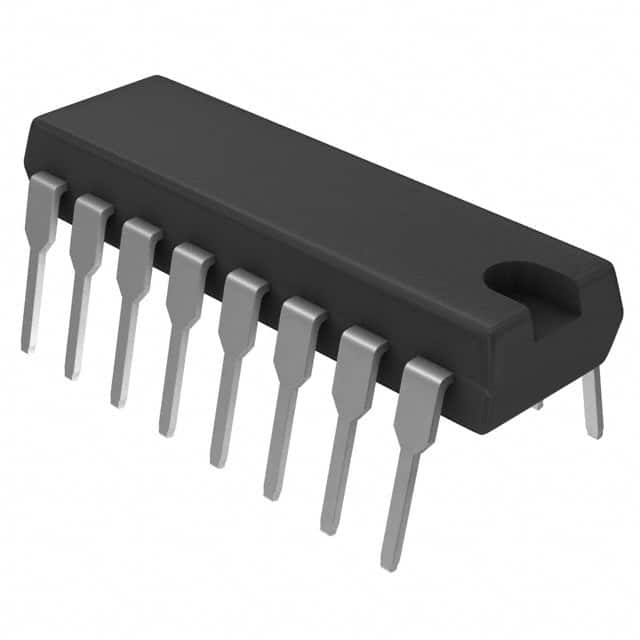Lihat spesifikasi untuk detail produk.

DS1305+ - English Editing Encyclopedia Entry
Product Overview
Category: Integrated Circuit (IC)
Use: Real-Time Clock (RTC) module
Characteristics: - Small form factor - Low power consumption - High accuracy timekeeping - Non-volatile memory for data storage - I2C interface for communication
Package: 8-pin SOIC (Small Outline Integrated Circuit)
Essence: The DS1305+ is a real-time clock module that provides accurate timekeeping functionality for various electronic devices.
Packaging/Quantity: The DS1305+ is typically sold in reels containing 250 units.
Specifications
- Supply Voltage: 2.0V to 5.5V
- Timekeeping Accuracy: ±2 minutes per month at 25°C
- Operating Temperature Range: -40°C to +85°C
- Battery Backup Voltage: 2.0V to 5.5V
- Battery Backup Current: 1.0μA (typical)
- I2C Bus Frequency: Up to 400kHz
Pin Configuration
The DS1305+ features an 8-pin SOIC package with the following pin configuration:
- VCC - Power supply voltage input
- GND - Ground reference
- SDA - Serial Data Line for I2C communication
- SCL - Serial Clock Line for I2C communication
- SQW/OUT - Square Wave Output or Interrupt Output
- RST - Reset Input
- NC - No Connection
- VBAT - Battery Backup Voltage Input
Functional Features
- Real-time clock with calendar functionality
- Battery backup support for continuous timekeeping during power loss
- Alarm and interrupt capabilities
- Programmable square wave output
- User-accessible non-volatile memory for data storage
- I2C interface for easy integration with microcontrollers and other devices
Advantages and Disadvantages
Advantages: - Small form factor allows for easy integration into compact designs - Low power consumption extends battery life in portable applications - High accuracy timekeeping ensures precise timing functionality - Non-volatile memory preserves data even during power loss - I2C interface simplifies communication with other devices
Disadvantages: - Limited number of available pins may restrict the use of additional features - Reliance on an external battery for backup power can increase system complexity
Working Principles
The DS1305+ utilizes a quartz crystal oscillator to generate accurate timekeeping signals. It incorporates a real-time clock circuit that counts seconds, minutes, hours, days, months, and years. The module also includes non-volatile memory to store configuration settings and user data. Communication with the DS1305+ is achieved through the I2C bus, allowing for easy integration with microcontrollers and other devices.
Detailed Application Field Plans
The DS1305+ finds applications in various electronic devices requiring accurate timekeeping functionality. Some potential application fields include:
Consumer Electronics:
- Digital clocks and watches
- Home automation systems
- Audio/video equipment
Industrial Automation:
- Programmable logic controllers (PLCs)
- Data loggers
- Timing and scheduling systems
Automotive:
- Car infotainment systems
- Dashboard clocks
- GPS navigation devices
Medical Devices:
- Patient monitoring systems
- Medical equipment timers
- Drug dispensing machines
Detailed and Complete Alternative Models
- DS3231 - Real-Time Clock module with higher timekeeping accuracy and temperature compensation.
- PCF8563 - Low-power Real-Time Clock module with alarm and timer functions.
- MCP7940N - Real-Time Clock module with battery backup and I2C interface.
- DS1337 - Real-Time Clock module with integrated temperature sensor and alarm functionality.
These alternative models offer similar timekeeping capabilities but may have different features and specifications to suit specific application requirements.
In conclusion, the DS1305+ is a compact and accurate real-time clock module that provides essential timekeeping functionality for various electronic devices. Its small form factor, low power consumption, and I2C interface make it suitable for integration into diverse applications. However, designers should consider alternative models based on their specific requirements.
Sebutkan 10 pertanyaan dan jawaban umum terkait penerapan DS1305+ dalam solusi teknis
Sure! Here are 10 common questions and answers related to the application of DS1305+ in technical solutions:
Q: What is DS1305+? A: DS1305+ is a real-time clock (RTC) module manufactured by Maxim Integrated. It provides accurate timekeeping and calendar functions for various technical applications.
Q: How does DS1305+ connect to a microcontroller or system? A: DS1305+ typically connects to a microcontroller or system using the I2C communication protocol, which requires two wires for data transfer.
Q: Can DS1305+ operate on its own without a microcontroller? A: Yes, DS1305+ has an integrated battery backup that allows it to function independently and maintain accurate timekeeping even without a microcontroller.
Q: What is the accuracy of DS1305+? A: DS1305+ has a typical accuracy of ±2 minutes per month when powered by a 3V coin cell battery.
Q: Can DS1305+ be used in low-power applications? A: Yes, DS1305+ has a low power consumption mode that can be enabled to minimize energy usage in battery-powered applications.
Q: Does DS1305+ support alarms or interrupts? A: Yes, DS1305+ has two programmable alarms that can trigger an interrupt signal to the microcontroller or system at specified times.
Q: Can DS1305+ handle daylight saving time changes automatically? A: No, DS1305+ does not have built-in functionality for automatic daylight saving time adjustments. This needs to be implemented in the software.
Q: What is the maximum operating temperature range for DS1305+? A: DS1305+ can operate within a temperature range of -40°C to +85°C.
Q: Can DS1305+ be used in industrial applications? A: Yes, DS1305+ is designed to meet the requirements of industrial applications and can withstand harsh environmental conditions.
Q: Are there any limitations or considerations when using DS1305+ in a design? A: Some considerations include proper power supply decoupling, ensuring correct I2C bus communication, and handling leap years in software for accurate calendar calculations.
Please note that these answers are general and may vary depending on specific implementation details and requirements.

